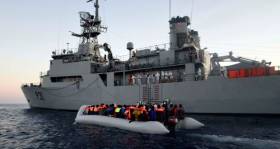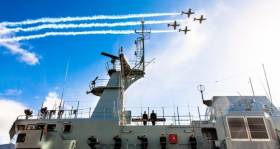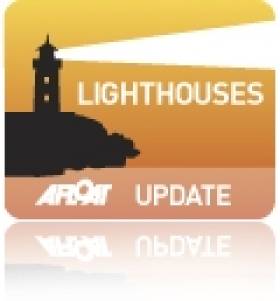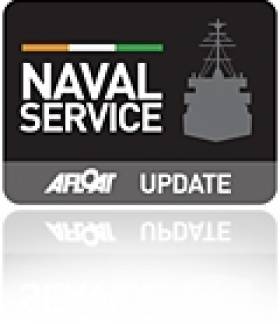Displaying items by tag: An Taoiseach
Naval Service Vessels Will Not Patrol Mediterranean Sea
A number of Irish Naval Service vessels, RTE reports, will not be able to patrol the Mediterranean Sea to assist with the rescue of migrants, the Taoiseach has told the Dáil.
Leo Varadkar said that as three Irish naval vessels are in operational reserve or undergoing maintenance, the navy's operations will be restricted.
Confirming that the Irish Navy will not be in a position to return to the Mediterranean he said: "We will have to focus on our seas and on fishery protection and drug interdiction instead."
Responding to questions from Sinn Féin leader Mary Lou McDonald, Mr Varadkar said: "Those vessels will be out of service until mid-September and late October. But with current staffing levels it is unlikely they will be brought back into service. So that means three ships will be held in operational reserve or in maintenance with the remaining six vessels fully operational.
"It does mean that some operations will be restricted, for example the naval service will not be able to return to the Mediterranean because we will have to focus on our seas and on fishery protection and drug interdiction instead."
For more including the Taoiseach and response from political opposition click here.
#HospitalShip - The Naval Service have plans for a newbuild which would be equipped to provide full medical facilities at sea have been endorsed by Taoiseach Enda Kenny.
The Irish Times writes that a White Paper on Defence promises a multi-purpose vessel equipped with a fully functioning hospital, Mr Kenny said in Galway docks on Monday.
This would allow medical personnel to serve in “war and conflict situations”, Mr Kenny said. He was speaking at the commissioning of the Naval Service’s latest new patrol ship, LÉ William Butler Yeats.
Mr Kenny said it was “his wish” that such a multi-purpose ship – still at pre-design stage – would be built to serve in humanitarian crises. It was in “keeping with our rich tradition of charity and volunteering”, he said.
For more on search and rescues in the Mediterranean and the ceremony for the newbuild held at Galway Port, click here.
Taoiseach to Open Exhibition at Loop Head Lighthouse
#LOOP HEAD LIGHTHOUSE – An Taoiseach Enda Kenny is to officially open a new exhibition at the Loop Head Lighthouse and to launch the 2012 visitor season at the west Clare tourist attraction on 18th May.
The Clare Herald also reports that the Taoiseach's grandfather, James McGinley was a former keeper at the lighthouse (still in operation) which can date its origins back to the 1670s.
Clare County Council, along with Shannon Development, Loop Head Tourism and the Commissioners of Irish Lights, conducted a successful trial scheme in 2011 that resulted in an estimated 17,000 people visiting the landmark building. This year's season will see the visitor attraction open to the public from 19th May.
In addition the Irish Landmark Trust rents out a five-bed former lighthouse-keepers house. The property stands in the grounds of the navigation landmark located at the mouth of the Shannon Estuary.
Navy Escort Detained Trawler to Castletownbere
Less then a month ago the Naval Service detained a Northern Irish registered fishing vessel the Lynn Marie seven miles east off Bray Head. Onboard was a crew of 4 UK nationals who were taken into custody to the Gardai after the trawler was escorted by the CPV L.E. Orla to Dun Laoghaire Harbour. To read more about this detention click here.
Ironically the L.E. Orla was a former Royal Naval vessel, HMS Swift (P241) which was deployed on her first assignment to the Hong Kong Patrol Squadron for a four-year period. In 1988 Margaret Thatcher's Conservative Party Government disposed HMS Swift and HMS Swallow (P242) to the Irish Naval Service. The pair were built by Hall Russell Shipyard of Aberdeen as part of an eight 'Peacock' class coastal patrol vessel (CPV).
The 'Peacock' pair were commissioned into the Naval Service and renamed L.E. Orla (P41) and L.E. Ciara (P42) in a ceremony attended by An Taoiseach Charles J. Haughey at the Naval Base in Haulbowline, Cork Harbour.
This weeks' detention is the second conducted by the Naval Service in 2011. Last year the Naval Service carried out 1,666 vessel boardings which resulted in 70 warnings and eight detentions.
- Irish Naval Service
- Cork Harbour
- Northern Ireland
- Haulbowline
- castletownbere
- naval service
- LE Niamh
- Royal Navy
- Ports and Shipping News
- Lynn Marie
- Fishery Breaches
- Fishery Detention
- Fishing Trawler
- Peacock Class
- Hong Kong
- Hall Russell
- Appledore Shipbuilders
- LE Orla
- HMS Swift
- LE Ciara
- HMS Swallow
- Margaret Thatcher
- Conservative Party
- An Taoiseach
- Charles J. Haughey
- Naval Base



























































